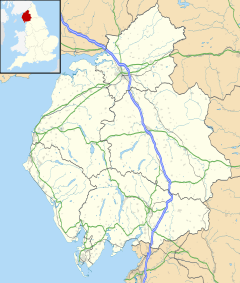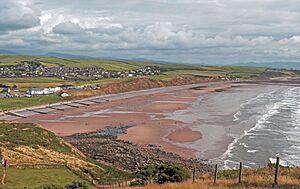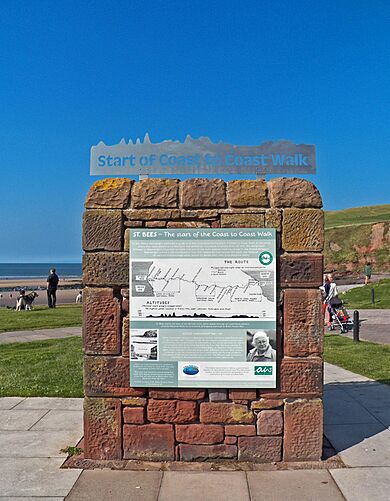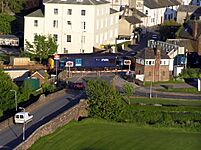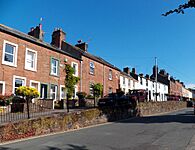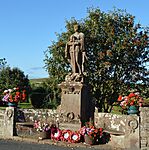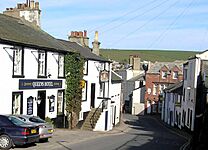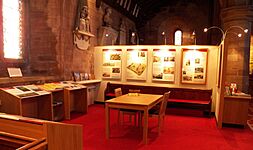St Bees facts for kids
Quick facts for kids St Bees |
|
|---|---|
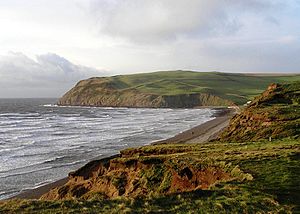 St Bees Head |
|
| Population | 1,801 (2011) |
| OS grid reference | NX971115 |
| Civil parish |
|
| District | |
| Shire county | |
| Region | |
| Country | England |
| Sovereign state | United Kingdom |
| Post town | ST. BEES |
| Postcode district | CA27 |
| Dialling code | 01946 |
| Police | Cumbria |
| Fire | Cumbria |
| Ambulance | North West |
| EU Parliament | North West England |
| UK Parliament |
|
St Bees is a lovely village by the sea in Cumbria, England. It sits right on the Irish Sea coast. This area is part of the Copeland district.
St Bees is famous for St Bees Head, which is a special coastline. It's the only "Heritage Coast" between Wales and Scotland! This area is also a Site of Special Scientific Interest and an RSPB bird reserve. You can see the only cliff-nesting seabirds in northwest England here. The St Bees Lighthouse stands on the North Head, which is the most westerly point in Northern England.
Many people visit St Bees for holidays because of its beautiful coastline. It's also close to the western part of the Lake District. In the village, you'll find St Bees Priory, a very old church built around 1120. There's also St Bees School, which started in 1583. The famous Wainwright Coast to Coast Walk begins right here in St Bees! The village also has a train station on the Cumbrian Coast Railway.
Contents
How Old is St Bees?
Scientists have found signs that people lived in St Bees a very long time ago. This includes the Mesolithic and Bronze Ages. However, there's no proof of Roman people living here. St Bees Head would have been a great spot for them to watch the coast.
The name "St Bees" comes from an old Norse name. The earliest records call it "Kyrkeby becok." This means "Church town of Bega." It's named after a local saint, Saint Bega. Legend says she was an Irish princess. She supposedly sailed across the Irish Sea in the 9th century to avoid a forced marriage. Carved stones at the priory show that Irish-Norse Vikings settled here in the 10th century.
The Normans and the Priory
The Normans arrived in this part of England around 1092. When they took control, a lord named William Meschin decided to build a priory. This was a type of monastery for monks. He used an existing religious site in St Bees. The priory was built between 1120 and 1135. It was connected to a larger monastery in York. The amazing Norman doorway of the priory was built around 1150.
The priory had a big impact on the area. The monks farmed, fished, and made the priory buildings bigger. The church area of St Bees was huge. It stretched to places like Ennerdale and Wasdale. Old paths called "coffin routes" still exist in some places. These were used to carry people from far-off areas to the main church in St Bees.
The Priory Closes Down
The priory was closed in 1539. This happened during the Dissolution of the Monasteries. King Henry VIII ordered all monasteries to close. The main part of the church is still used today as the local parish church. But many of the other monastery buildings were destroyed or fell apart.
Amazingly, two important church leaders came from the small village of St Bees. They both became archbishops during the time of Queen Elizabeth I. These were Edmund Grindal, who became Archbishop of Canterbury, and Edwin Sandys, who became Archbishop of York.
Edmund Grindal was born in St Bees around 1519. His birthplace, Cross Hill House, is still there today. He probably went to school at the priory. He was a strong Protestant. He became important during the reign of King Edward VI. But he had to leave England when the Catholic Queen Mary I became queen. When Mary died, England became Protestant again. Grindal then became a bishop, then Archbishop of York, and finally Archbishop of Canterbury. He disagreed with Queen Elizabeth I about religious meetings and was suspended. He died in 1583. Just before he died, he founded St Bees School. The village's primary school started later, in the 1870s.
How St Bees Grew Over Time
The original village of St Bees was built on high, firm ground near the priory. This area was a bit small. As the village grew, it spread to the other side of the valley. The oldest house still standing is from the early 16th century. Main Street used to be a row of farms and homes for farmworkers.
Changes in the 1800s
The 19th century brought big changes to St Bees. In 1816, St Bees Theological College opened. This was a school to train Church of England priests. It was the first of its kind outside of Oxford and Cambridge universities. The old chancel of the Priory was re-roofed and used as a main classroom. More classrooms were built in the 1860s. At one point, the college had 100 students. Over 2,600 priests were trained there before it closed in 1895.
St Bees School also grew a lot. New buildings were added, starting in 1846. This helped the school become one of the new "public schools," like Dr Arnold's Rugby School. By 1916, there were 350 students. The school became well-known across the country. It had to close in 2015 because of money problems. But it reopened a few years later.
The arrival of the Furness Railway in 1849 also changed St Bees. Professional people who worked in Whitehaven or Workington started moving to St Bees. This led to many larger houses being built. The railway also brought tourists. As early as 1851, the Lord Mayor of London stayed at the Seacote Hotel. St Bees has been a popular holiday spot ever since.
The railway also made it possible to send St Bees sandstone to other places. A lot of stone was dug up. Much of it was used to build the fast-growing town of Barrow-in-Furness. This industry stopped in the 1970s. But it has started again, and there are now two working quarries in the area.
St Bees Today
Farming used to be the main way people made a living in St Bees. In the 1800s, jobs at the school and college provided more income. As people who worked in cities moved in, the village became more mixed. Tourism and quarries also created jobs. Many men from the village worked in iron ore mines nearby. So, the 19th century changed St Bees from a small farming village to a place with many different types of jobs. It also became a small center for education.
In the 20th century, farming continued to decline. Now, only a few farms are left. Other industries in West Cumbria also struggled. However, after the Second World War, two big industries started. These were the Marchon Chemical Company in Whitehaven and BNFL at Sellafield. They hired many people from the village. They also brought many educated people to St Bees. This was similar to when the first professional people arrived a century earlier. Today, there is a large science park called Westlakes nearby. The Nuclear Decommissioning Authority has its main office there.
In the last 20 years, tourism has grown a lot again. The Coast to Coast walk has helped with this. People are also realizing how special the St Bees Heritage Coast is. In 2014, St Bees was even named one of the most attractive places to live in England!
The St Bees Man
In 1981, archaeologists were digging at the priory. They found a hidden room with a lead coffin. Inside was an amazingly well-preserved body! This body is now known as the St Bees Man. He has been identified as Anthony de Lucy, a knight. He died in 1368 during the Northern Crusades in Lithuania. Even though the body was over 600 years old, his nails, skin, and even what was in his stomach were almost perfect. After he died, the room was made bigger for his sister, Maud de Lucy. She died in 1398. You can see statues of Maud and Anthony in a history display at the priory. The display also includes the cloth he was wrapped in.
Getting Around St Bees
The village has a train station called St Bees railway station. It's on the Cumbrian Coast Line. You can catch trains from places like Barrow-in-Furness and Carlisle. There are many trains running every day.
The B5345 road also goes through the village. It connects Whitehaven to Iron Bridge junction.
Sports and Fun in St Bees
The village has a football team that plays in the Cumbria County league.
There are places for rugby, football, and cricket at the Adams recreation ground. This field is next to Seacote beach. It was made to remember Baron Adams of Ennerdale. St Bees School also has sports facilities that can be used. These include a sports hall, courts for squash, tennis, and fives, and an indoor swimming pool.
At St Bees, you can do many activities by the sea. These include windsurfing, kite-surfing, rock climbing, swimming, jet-skiing, water-skiing, canoeing, and paragliding. These happen on St Bees Head and off the big sandy beach.
A circular walk around St Bees Head and Birkhams quarry was featured in a newspaper. The Daily Telegraph called it one of the best coastal walks in the UK in 2012.
The Coast to Coast Walk Starts Here!
St Bees is the starting point for the famous Wainwright Coast to Coast Walk. This walk was created by Alfred Wainwright in 1973. It's a long walking path, about 192-mile (309 km) long. It's not an official trail, and it doesn't have many signs.
The walk goes through three different National Parks. These are the Lake District National Park, the Yorkshire Dales National Park, and the North York Moors National Park. Wainwright suggested that walkers dip their feet in the Irish Sea at St Bees at the start. Then, at the end of the walk, they should dip their feet in the North Sea at Robin Hood's Bay. In St Bees, the start of the walk is marked by a "Wainwright Wall." This wall tells you about the walk and its history. A new sign and steel banner were put up in 2013.
Images for kids
St Bees Beach
See also
 In Spanish: St Bees para niños
In Spanish: St Bees para niños


